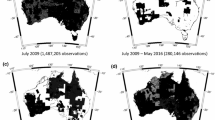Abstract
The tide-free release of the EGM2008 combined global geopotential model and its pre-release PGM2007A are compared with Australian land and marine gravity observations, co-located GPS-levelling on the [admittedly problematic] Australian Height Datum, astrogeodetic deflections of the vertical, and the AUSGeoid98 regional gravimetric quasigeoid model. The results show that we cannot legitimately claim to truly validate EGM2008. Instead, EGM2008 confirms already-known problems with the Australian data, as well as revealing some previously unknown problems. If one wants to claim validation, then EGM2008 is validated because it can confirm the errors in our regional data. Simply, EGM2008 is a good model over Australia.
Access this chapter
Tax calculation will be finalised at checkout
Purchases are for personal use only
Similar content being viewed by others
References
Claessens, S.J., W.E. Featherstone, and F. Barthelmes (2001). Experiences with point-mass modelling in the Perth region, Western Australia. Geomatics Res.Australasia 75, 53–86.
Featherstone, W.E. (2001). Absolute and relative testing of gravimetric geoid models using Global Positioning System and orthometric height data. Comput. Geosci., 27(7), 807–814, doi: 10.1016/S0098-3004(00)00169-2.
Featherstone, W.E. (2003). Improvement to long-wavelength Australian gravity anomalies expected from the GRACE, CHAMP and GOCE dedicated satellite gravimetry missions. Explor. Geophys., 34(1–2), 69–76.
Featherstone, W.E. (2004). Evidence of a north-south trend between AUSGeoid98 and AHD in southwest Australia. Surv. Rev., 37(291), 334–343.
Featherstone, W.E. (2006). Yet more evidence for a north-south slope in the AHD. J. Spatial Sci., 51(2), 1–6; corrigendum in 52(1), 65–68.
Featherstone, W.E. et al. (2001). The AUSGeoid98 geoid model of Australia: data treatment, computations and comparisons with GPS/levelling data. J. Geod., 75(5–6), 313–330, doi: 10.1007/s001900100177.
Featherstone, W.E. et al. (2004). GPS-geodetic monitoring of the southwest seismic zone of Western Australia: epoch-one. J. Royal Soc. WA., 87(1), 1–9.
Featherstone, W.E. et al. (2007). Progress towards the new Australian geoid-type model as a replacement for AUSGeoid98, Proc SSC2007, Hobart, May [CD-ROM].
Jekeli, C. (1999). An analysis of vertical deflections derived from high-degree spherical harmonic models. J. Geod., 73(1), 10–22, doi: 10.1007/s001900050213.
Kearsley, A.H.W. (1976). The computation of deflections of the vertical from gravity anomalies, UNISURV Rep S15, Univ of NSW, Sydney, p. 161.
Kirby, J.F., W.E. Featherstone, and A.H.W. Kearsley (1998). Tests of the DMA/GSFC geopotential models over Australia. Int. Geod. Serv. Bull., 7, 2–13.
Lemoine, F.G. et al. (1998). The development of the joint NASA, GSFC and the National Imagery and Mapping Agency (NIMA) geopotential model EGM96, NASA/TP-1998-206861, NASA, Greenbelt, p. 575.
Mather, R.S., C. Rizos, B. Hirsch, and B.C. Barlow (1976). An Australian gravity data bank for sea surface topography determinations (AUSGAD76), UNISURV G25, School of Surveying, Univ of NSW, Sydney, pp. 54–84.
Murray, A.S. (1997). The Australian national gravity database. AGSO J. Aust. Geol. Geophys., 17, 145–155.
Pavlis, N.K., S.A. Holmes, S.C. Kenyon, and J.K. Factor (2008). An earth gravitational model degree 2160: EGM2008. Presented at the 2008 General Assembly of the European Geosciences Union, Vienna, Austria, April 13–18.
Roelse, A., H.W. Granger, and J.W. Graham (1971). The adjustment of the Australian levelling survey 1970-1971, Tech Rep 12, Div of National Mapping, Canberra, p. 81.
Sandwell, D.T. and W.H.F. Smith (1997). Marine gravity anomaly from Geosat and ERS-1 altimetry. J. Geophys. Res., 102(B5), 10039–10054.
Soltanpour, A., H. Nahavandchi, and W.E. Featherstone (2006). The use of second-generation wavelets to combine a gravimetric geoid model with GPS-levelling data. J. Geod., 80(2), 82–93, doi: 10.1007/s00190-006-0033-0.
Symonds, P.A. and J.B. Willcox (1976). The gravity field offshore Australia. BMR J. Aust. Geol. Geophys., 1(1), 303–314.
Tapley, B. et al. (2005). GGM02 – An improved Earth gravity field model from GRACE. J. Geod., 79(8), 467–478, doi: 10.1007/s00190-005-0480-z.
Tregoning, P., K. Lambeck, and G. Ramillien (2008). GRACE estimates of sea surface height anomalies in the Gulf of Carpentaria, Australia. Earth Planet. Sci. Lett. 271(1–4), 241–244, doi: 10.1016/j.epsl.2008.04.018.
Acknowledgements
We acknowledge funding from the Australian Research Council via grant DP0663020. Naturally, the suppliers of data are thanked too.
Author information
Authors and Affiliations
Corresponding author
Editor information
Editors and Affiliations
Rights and permissions
Copyright information
© 2010 Springer-Verlag Berlin Heidelberg
About this paper
Cite this paper
Claessens, S.J., Featherstone, W.E., Anjasmara, I.M. (2010). Is Australian Data Really Validating EGM2008, or Is EGM2008 Just in/Validating Australian Data?. In: Mertikas, S. (eds) Gravity, Geoid and Earth Observation. International Association of Geodesy Symposia, vol 135. Springer, Berlin, Heidelberg. https://doi.org/10.1007/978-3-642-10634-7_63
Download citation
DOI: https://doi.org/10.1007/978-3-642-10634-7_63
Published:
Publisher Name: Springer, Berlin, Heidelberg
Print ISBN: 978-3-642-10633-0
Online ISBN: 978-3-642-10634-7
eBook Packages: Earth and Environmental ScienceEarth and Environmental Science (R0)




